1. The Diversity of Life by Edward O. Wilson
 This amazing book tells the story of how life on earth became so diverse and stresses our obligations to conserve ecosystems and not just single species. He writes: “Now the value of the little things in the natural world has become compellingly clear. Recent experimental studies on whole ecosystems support what was long suspected: in most cases, the more species living in an ecosystem, the higher its productivity and the greater its ability to withstand drought and other kinds of environmental stress. Since we depend on an abundance of functioning ecosystems to cleanse our water, enrich our soil, and manufacture the very air we breathe, biodiversity is clearly not an inheritance to be discarded carelessly.” It is a warning that could well be heeded by grouse moor owners destroying as they do any living creature that interferes with producing record breaking numbers of Red Grouse so that a few very rich sportsmen can enjoy shooting them.
This amazing book tells the story of how life on earth became so diverse and stresses our obligations to conserve ecosystems and not just single species. He writes: “Now the value of the little things in the natural world has become compellingly clear. Recent experimental studies on whole ecosystems support what was long suspected: in most cases, the more species living in an ecosystem, the higher its productivity and the greater its ability to withstand drought and other kinds of environmental stress. Since we depend on an abundance of functioning ecosystems to cleanse our water, enrich our soil, and manufacture the very air we breathe, biodiversity is clearly not an inheritance to be discarded carelessly.” It is a warning that could well be heeded by grouse moor owners destroying as they do any living creature that interferes with producing record breaking numbers of Red Grouse so that a few very rich sportsmen can enjoy shooting them.
2. A Sand County Almanac by Aldo Leopold
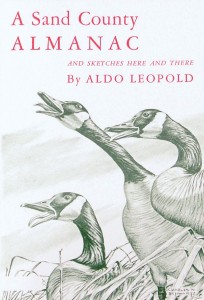 Forty years ago Richard Mabey urged me to read this book and one passage in it was so brilliant that it has stayed with me ever since. It’s about cutting up a veteran oak tree. “We sensed that these two piles of sawdust were something more than wood: that they were the integrated transect of a century; that our saw was biting its way, stroke by stroke, decade by decade, into the chronology of a life time, written in concentric annual rings of good oak. We cut 1906, when the first state forester took office, and fires burned 17,000 acres in these sand counties; we cut 1905 when a great flight of goshawks came out of the north and ate up the local grouse (they no doubt perched in this tree to eat some of mine). In 1871, within a 50 mile triangle spreading north-westward from my oak, 136 million pigeons are estimated to have nested, and some may have nested in it, for it was a thrifty sapling 20 feet tall. Pigeon hunters by scores plied their trade with net and gun, club and salt lick, and trainloads of prospective pigeon pie moved southward and eastward towards the cities. It was the last big nesting in Wisconsin, and nearly the last in any state. Rest! Cries the chief sawyer, and we pause for breath.”
Forty years ago Richard Mabey urged me to read this book and one passage in it was so brilliant that it has stayed with me ever since. It’s about cutting up a veteran oak tree. “We sensed that these two piles of sawdust were something more than wood: that they were the integrated transect of a century; that our saw was biting its way, stroke by stroke, decade by decade, into the chronology of a life time, written in concentric annual rings of good oak. We cut 1906, when the first state forester took office, and fires burned 17,000 acres in these sand counties; we cut 1905 when a great flight of goshawks came out of the north and ate up the local grouse (they no doubt perched in this tree to eat some of mine). In 1871, within a 50 mile triangle spreading north-westward from my oak, 136 million pigeons are estimated to have nested, and some may have nested in it, for it was a thrifty sapling 20 feet tall. Pigeon hunters by scores plied their trade with net and gun, club and salt lick, and trainloads of prospective pigeon pie moved southward and eastward towards the cities. It was the last big nesting in Wisconsin, and nearly the last in any state. Rest! Cries the chief sawyer, and we pause for breath.”
3. The Natural History of Selborne by Gilbert White
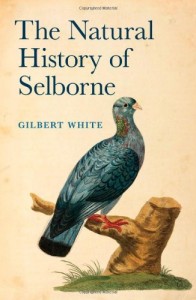 The Reverend Gilbert White centred himself at Selborne in Hampshire for nearly forty years between 1754 and 1793, White kept a meticulous daily journal that noted variations in the weather and his observations on birds and their behaviour. His doctrine was: “Men that undertake only one district are much more likely to advance natural knowledge than those that grasp at more than they can possibly be acquainted with.” Using this method, he did, for example, discover three new birds. He was able to separate the leaf warblers into three distinct species – the chiffchaff, the wood warbler and willow warbler. Here is his entry for “24th May 1792. Tanner shot a hen Sparrow-hawk as she was sitting on her eggs in an old crow’s nest on one of the beeches in the High Wood. The bird fell to the ground, and what was very strange, brought down with her one of the eggs unbroken. The eggs of the Sparrow-hawks, like those of other birds of prey, are round, and blunt-ended, and marked at one end with a bloody blotch. The hen bird of this species is a fine large hawk; the male is much smaller, and more slender. Hawks seldom build any nest. This hawk had in her craw the limbs of an unfledged lark.” He has quite rightly been called the Father of Ornithological Ecology.
The Reverend Gilbert White centred himself at Selborne in Hampshire for nearly forty years between 1754 and 1793, White kept a meticulous daily journal that noted variations in the weather and his observations on birds and their behaviour. His doctrine was: “Men that undertake only one district are much more likely to advance natural knowledge than those that grasp at more than they can possibly be acquainted with.” Using this method, he did, for example, discover three new birds. He was able to separate the leaf warblers into three distinct species – the chiffchaff, the wood warbler and willow warbler. Here is his entry for “24th May 1792. Tanner shot a hen Sparrow-hawk as she was sitting on her eggs in an old crow’s nest on one of the beeches in the High Wood. The bird fell to the ground, and what was very strange, brought down with her one of the eggs unbroken. The eggs of the Sparrow-hawks, like those of other birds of prey, are round, and blunt-ended, and marked at one end with a bloody blotch. The hen bird of this species is a fine large hawk; the male is much smaller, and more slender. Hawks seldom build any nest. This hawk had in her craw the limbs of an unfledged lark.” He has quite rightly been called the Father of Ornithological Ecology.
4. Arctic Dreams by Barry Lopez
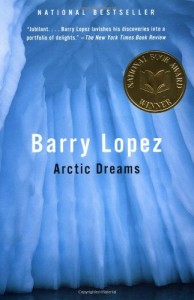 For 5 years Barry Lopez travelled around the Arctic as a field biologist before writing this book. It encompasses not only the unique fauna and flora of the region but also the history of exploration, the drive to find a north-west passage, a short cut, linking the Atlantic to the Pacific. It is full of memorable passages of which this is my favourite. “I bring my glasses up to study again the muskoxen in the far valley to the south. Among fifty or sixty animals are ten or fifteen calves. I regard them for a while, until I hear the clattering alarm call of a sandhill crane. To the southwest an arctic hare rises up immediately, smartly alert. To the southeast a snowy owl sitting on a tussock, as conspicuous in its whiteness as the hare, pivots its head far round, right then left. The hare, as intent as if someone had whistled, has found me and fixed me with his stare. In that moment I feel the earth bent like a bow and sense the volume of space between us, as though the hare, the owl, and I stood on a dry lakebed. The moment lasts until the hare drops, becomes absorbed again in the leaves of a willow. The owl returns its gaze to the river valley below. The indictment of the sandhill cranes continues; I shift my perch so they cannot see me, and their calls cease.”
For 5 years Barry Lopez travelled around the Arctic as a field biologist before writing this book. It encompasses not only the unique fauna and flora of the region but also the history of exploration, the drive to find a north-west passage, a short cut, linking the Atlantic to the Pacific. It is full of memorable passages of which this is my favourite. “I bring my glasses up to study again the muskoxen in the far valley to the south. Among fifty or sixty animals are ten or fifteen calves. I regard them for a while, until I hear the clattering alarm call of a sandhill crane. To the southwest an arctic hare rises up immediately, smartly alert. To the southeast a snowy owl sitting on a tussock, as conspicuous in its whiteness as the hare, pivots its head far round, right then left. The hare, as intent as if someone had whistled, has found me and fixed me with his stare. In that moment I feel the earth bent like a bow and sense the volume of space between us, as though the hare, the owl, and I stood on a dry lakebed. The moment lasts until the hare drops, becomes absorbed again in the leaves of a willow. The owl returns its gaze to the river valley below. The indictment of the sandhill cranes continues; I shift my perch so they cannot see me, and their calls cease.”
5. The Peregrine by J.A.Baker
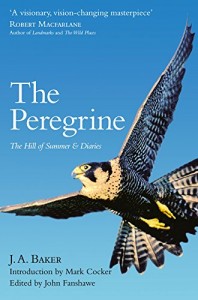 Baker’s book is an extraordinary account of his obsession with a pair of Peregrine Falcons, autumn migrants, that came to hunt over the coastal marshes near his home in Essex. It is set during the period when Peregrines in England had been decimated by pesticides. From October through to April he follows and observes the birds relentlessly. He invents a new language to describe the Peregrine’s skill at killing: “She dropped. The beaches flared and roared with salvoes of white wings. The sky shredded up, was torn by whirling birds. The falcon rose and fell, like a black billhook in splinters of white wood.” Here the falcon kills a Wood Pigeon: “one bird fell back, gashed dead, looking astonished, like a man falling out of a tree. The ground came up and crushed it.” And finally, my favourite passage: “the dunlin seemed to come slowly back to the hawk. It passed into his dark outline and did not re-appear.”
Baker’s book is an extraordinary account of his obsession with a pair of Peregrine Falcons, autumn migrants, that came to hunt over the coastal marshes near his home in Essex. It is set during the period when Peregrines in England had been decimated by pesticides. From October through to April he follows and observes the birds relentlessly. He invents a new language to describe the Peregrine’s skill at killing: “She dropped. The beaches flared and roared with salvoes of white wings. The sky shredded up, was torn by whirling birds. The falcon rose and fell, like a black billhook in splinters of white wood.” Here the falcon kills a Wood Pigeon: “one bird fell back, gashed dead, looking astonished, like a man falling out of a tree. The ground came up and crushed it.” And finally, my favourite passage: “the dunlin seemed to come slowly back to the hawk. It passed into his dark outline and did not re-appear.”
6. Tarka the Otter by Henry Williamson
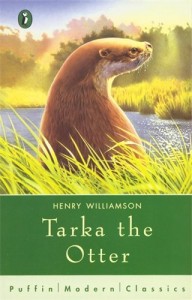 This wonderful book about an otter is written “red in tooth and claw” and brings home in vivid detail the cruelty of otter hunting. It was written just after the first World War. I was very lucky when Henry Williamson asked me if I’d like to turn his book into a film. Here are three of my favourite prose passages: “Tarka was alone, a young male of a ferocious and persecuted tribe whose only friends, except the Spirit that made it, were his enemies – the otter-hunters. His cubhood was ended, and now indeed did his name fit his life, for he was a wanderer, and homeless, with nearly every man and dog against him.” Tarka falls in love with Whitetip and they raise a family of cubs. Tarquol was his favourite: “Tarka slept, while the water flowed, and he dreamed of a journey with Tarquol down to a strange sea, where they were never hungry, and never hunted.” The end is like a Greek tragedy. Tarka and his nemesis, Deadlock, the otter hound have a fight to the death. This is the final sentence: “And while they stood there silently, a great bubble rose out of the depths, and broke, and as they watched, another bubble shook the surface, and broke; and there was a third bubble in the sea-going waters, and nothing more.” We held a preview of the film for children in London and afterwards they clustered round to ask questions. After almost everyone had gone I was left with a girl looking up at me. “Did you enjoy it?” I asked. “Yes, but it made me cry.” I replied “That’s nothing to be ashamed of. If you’d felt nothing I would have been disappointed. You should be proud that the story moved you – thank you.”
This wonderful book about an otter is written “red in tooth and claw” and brings home in vivid detail the cruelty of otter hunting. It was written just after the first World War. I was very lucky when Henry Williamson asked me if I’d like to turn his book into a film. Here are three of my favourite prose passages: “Tarka was alone, a young male of a ferocious and persecuted tribe whose only friends, except the Spirit that made it, were his enemies – the otter-hunters. His cubhood was ended, and now indeed did his name fit his life, for he was a wanderer, and homeless, with nearly every man and dog against him.” Tarka falls in love with Whitetip and they raise a family of cubs. Tarquol was his favourite: “Tarka slept, while the water flowed, and he dreamed of a journey with Tarquol down to a strange sea, where they were never hungry, and never hunted.” The end is like a Greek tragedy. Tarka and his nemesis, Deadlock, the otter hound have a fight to the death. This is the final sentence: “And while they stood there silently, a great bubble rose out of the depths, and broke, and as they watched, another bubble shook the surface, and broke; and there was a third bubble in the sea-going waters, and nothing more.” We held a preview of the film for children in London and afterwards they clustered round to ask questions. After almost everyone had gone I was left with a girl looking up at me. “Did you enjoy it?” I asked. “Yes, but it made me cry.” I replied “That’s nothing to be ashamed of. If you’d felt nothing I would have been disappointed. You should be proud that the story moved you – thank you.”
7. Kings Solomon’s Ring by Konrad Lorenz
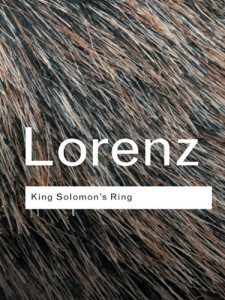 I was reading Natural Sciences at Cambridge when Konrad Lorenz’s book came out. Bill Thorpe, one of the lecturers in the Zoology Department, brought it to my attention. Suddenly, a whole new study of animal behaviour beckoned with words like “imprinting” and “releaser” mechanisms. The book’s title derives from a legend that Solomon possessed a magic ring that enabled him to speak to the animals in their own language.
I was reading Natural Sciences at Cambridge when Konrad Lorenz’s book came out. Bill Thorpe, one of the lecturers in the Zoology Department, brought it to my attention. Suddenly, a whole new study of animal behaviour beckoned with words like “imprinting” and “releaser” mechanisms. The book’s title derives from a legend that Solomon possessed a magic ring that enabled him to speak to the animals in their own language.
In 1935 Lorenz discovered that goslings became fixed, “imprinted”, on the first object that they saw after hatching. In his most successful experiment, using eggs hatched in an incubator, he took the place of the goose. Without hesitation the goslings followed in his footsteps. He tells the story of how, shortly before the second World War, he was walking by the Danube and he saw 13 Greylag geese flying past him. He knew that they were his geese because the second bird on the left of the gaggle had lost a primary. How did he know? The geese had been allowed the run of the house and one of the geese, Martin, flew into a chandelier and lost a primary. “When I come home from my walk, these grey geese will be standing on the steps of the veranda and they will come to greet me, their necks outstretched in that gesture which, in geese, means the same as tail-wagging in a dog. As I watched the geese, it appeared to me as little short of a miracle that a hard, matter of fact scientist should have been able to establish a real friendship with wild, free-living animals, and the realization of this fact made me strangely happy.”
8. The Snow Leopard by Peter Matthiessen
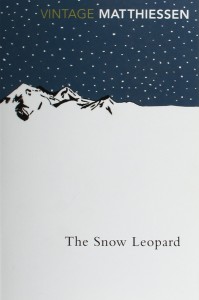 In September 1973. George Schaller, eminent field zoologist, and Peter Matthiessen, writer and zen-budhist set out from Kathmandhu to reach the Crystal Mountain on the Tibetan Plateau. Schaller wanted to study the Himalayan blue sheep during their “rutting season” and there might be a chance of seeing a Snow Leopard. Never has the saying: “It’s the journey not the arrival that matters” seemed so apt. They were late starting out and the author found Schaller “single minded, not easy to know.” They seemed an ill suited pair. Carrying their gear were 4 sherpas and 14 porters. There are delays, the sherpas fall behind and Schaller is convinced they will miss the “rut.” Ahead of them they see a precipitous ledge, even Schaller was taken aback by the sight of it. “That’s not something you’d want to do every day.” Matthiessen tackled it on his own the next day. There was “one horrid stretch, lacking the smallest handhold. This I navigate on my hands and knees. Gasping for breath, I let the expedition pass.” Schaller squeezes past him. “This is the first really interesting stretch of trail we’ve had so far.” How easy it would be to push him over. More delays with the porters but at last they reach the snowline. “On 1st November “a white pyramid sails on the sky – the Crystal Mountain.” People are drawn to it from near and far, undergoing untold privations and hardships to worship the centre of this sacred power. It had taken them 35 days of hard slog to reach it.
In September 1973. George Schaller, eminent field zoologist, and Peter Matthiessen, writer and zen-budhist set out from Kathmandhu to reach the Crystal Mountain on the Tibetan Plateau. Schaller wanted to study the Himalayan blue sheep during their “rutting season” and there might be a chance of seeing a Snow Leopard. Never has the saying: “It’s the journey not the arrival that matters” seemed so apt. They were late starting out and the author found Schaller “single minded, not easy to know.” They seemed an ill suited pair. Carrying their gear were 4 sherpas and 14 porters. There are delays, the sherpas fall behind and Schaller is convinced they will miss the “rut.” Ahead of them they see a precipitous ledge, even Schaller was taken aback by the sight of it. “That’s not something you’d want to do every day.” Matthiessen tackled it on his own the next day. There was “one horrid stretch, lacking the smallest handhold. This I navigate on my hands and knees. Gasping for breath, I let the expedition pass.” Schaller squeezes past him. “This is the first really interesting stretch of trail we’ve had so far.” How easy it would be to push him over. More delays with the porters but at last they reach the snowline. “On 1st November “a white pyramid sails on the sky – the Crystal Mountain.” People are drawn to it from near and far, undergoing untold privations and hardships to worship the centre of this sacred power. It had taken them 35 days of hard slog to reach it.
It was time to study the Bharal sheep and hope for a glimpse of a Snow Leopard. “Climbing, I transverse the snow slopes with my zigzag technique. Stopping and stooping and signalling to the browsing sheep that I am a harmless dung seeker. The animals have let me come so close that I can admire their orange eyes. At this early stage of the rut, the recipients of rump-rub and urine check pay little heed to their admirers.” They search for signs of the Snow Leopard. Schaller says: “There ought to be a leopard scat out on that next point it’s just the sort of place they choose.” And there it is all but glowing in the path. They find lots of footprints but never see it. Then Schaller says: “You know something? We’ve seen so much, maybe it’s better if there are some things we don’t see.”
On 18th November Matthiessen starts his journey home. Schaller says: “I’m sorry as hell to see you go.” And I say “I’m sorry as hell to leave.” As I set off, there at my feet, are fine fresh wolf tracks in the snow. I turn to yell about the wolves, but the sky is empty. There is only snow, whirling around the ancient cairn in golden sparkles. It is an awe inspiring book.
9. Silent Fields by Roger Lovegrove
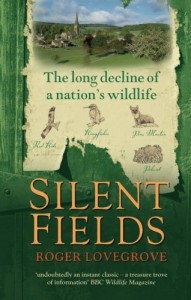 Silent Fields tells the story our ruthless and systematic assault on the nation’s wildlife from Tudor times to the present. Roger Lovegrove with his meticulous research has gathered together the history of the persecution of some of our best-loved and some our rarest wildlife species.
Silent Fields tells the story our ruthless and systematic assault on the nation’s wildlife from Tudor times to the present. Roger Lovegrove with his meticulous research has gathered together the history of the persecution of some of our best-loved and some our rarest wildlife species.
After a succession of severe winters resulting in severe food shortages, Queen Elizabeth the first, in 1566, introduced ‘An Acte for the Preservation of Grayne.’ It contains a long list of mammals and birds which by stretching the imagination might possibly impact on Man’s interest in agriculture. The Bullfinch was specifically singled out as was the Kingfisher. A tariff was published of what would be paid for a comprehensive list of small mammals, foxes, wildcats, starlings and many birds of prey that were considered pests. The body or head had to be offered up as proof. An Osprey’s head was worth four pence, two pence for Buzzards and
Harriers and a Fox or Badger’s head twelve pence. Churchwardens were responsible for the administration of this new Act which was not repealed until 1863. The Game Act of 1831 allowed gamekeepers free reign in destroying any animal that interfered with the pursuit of birds shot for sport. Roger Lovegrove points out the level of killing that ensued on the Glengarry Estate in Scotland between 1837-40: Wild Cat 198, White-tailed sea eagles 27, Blue hawks (harriers) 98, Kites 275, Common buzzards 285, Rough-legged buzzards 371, Kestrels 462, Merlins 78, and Hen harriers 63. There were respites from this wholesale slaughter. Two World Wars meant that keepers joined up allowing the population of birds of prey to build up again. The 1954 Protection of Birds Act protected all birds of prey except the Sparrowhawk. During this period the introduction of organo-chlorine pesticides virtually wiped out the Sparrowhawk in lowland England, achieving what gamekeepers had been trying to achieve for years. It was added to the protected list in 1961. Silent Fields is a diligently researched book with the facts of Man’s ruthless persecution through the ages of any bird or mammal that interferes with game preservation starkly laid out. It is a very thought provoking book.
10. Birds Britannica by Richard Mabey & Mark Cocker
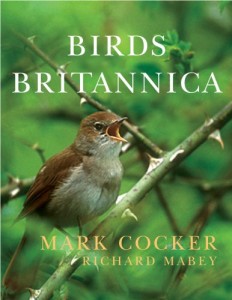 This is a mammoth book involving eight years of research and writing. It was started by Richard Mabey as a follow-up to his much praised Flora Britannica but he fell ill and it was taken over by Mark Cocker.
This is a mammoth book involving eight years of research and writing. It was started by Richard Mabey as a follow-up to his much praised Flora Britannica but he fell ill and it was taken over by Mark Cocker.
The book deals with birds in their taxonomic order. Therefore we start with the Red-throated diver and finish with the Reed Bunting. What makes Birds Britannica special is the inclusion of observations and experiences from more than 1,000 naturalists and bird lovers. These touch on avian ecology; the lore and language of birds; their myths; the art and literature they have inspired; birds as food; and the crucial role they play in our sense of place and the changing seasons.
I started this review of ten books on the Natural World which you must read with a quote from Edward O. Wilson’s The Diversity of Life on the importance of our ecosystems and related it to the sad fate of many of our birds of prey today. Let me finish with a quote from Birds Britannica on the Peregrine Falcon by the late Derek Ratcliffe in 2003, a prescient thought which may have shaped the ambitions of their champions today.
“Whereas the shooters derive enjoyment from killing birds, the bird of prey enthusiasts find pleasure in seeing the creatures alive and celebrating their existence as marvels of evolution. If the professed “sportsmen” cannot tolerate other natural predators sharing their domain, then the pressure will increase to close down their sport completely. Today there are many more people who enjoy watching birds than enjoy shooting them, and if it turns into a contest between the two groups, the watchers will win. The peregrine could become a new symbol for the passing of a field activity which however long its traditions, is no longer acceptable in the twenty-first century.”
